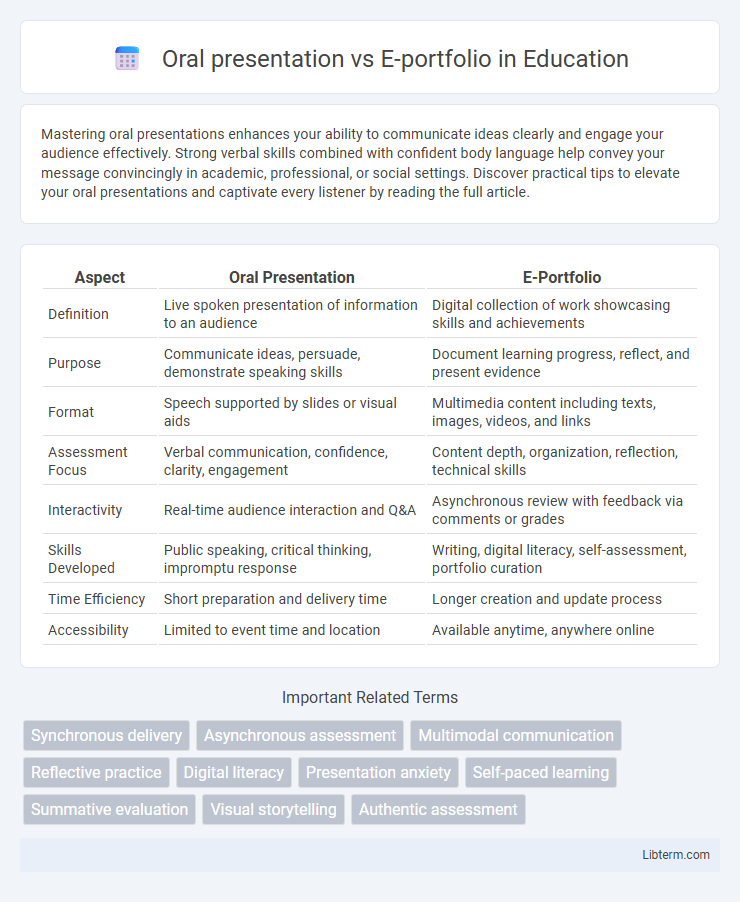Mastering oral presentations enhances your ability to communicate ideas clearly and engage your audience effectively. Strong verbal skills combined with confident body language help convey your message convincingly in academic, professional, or social settings. Discover practical tips to elevate your oral presentations and captivate every listener by reading the full article.
Table of Comparison
| Aspect | Oral Presentation | E-Portfolio |
|---|---|---|
| Definition | Live spoken presentation of information to an audience | Digital collection of work showcasing skills and achievements |
| Purpose | Communicate ideas, persuade, demonstrate speaking skills | Document learning progress, reflect, and present evidence |
| Format | Speech supported by slides or visual aids | Multimedia content including texts, images, videos, and links |
| Assessment Focus | Verbal communication, confidence, clarity, engagement | Content depth, organization, reflection, technical skills |
| Interactivity | Real-time audience interaction and Q&A | Asynchronous review with feedback via comments or grades |
| Skills Developed | Public speaking, critical thinking, impromptu response | Writing, digital literacy, self-assessment, portfolio curation |
| Time Efficiency | Short preparation and delivery time | Longer creation and update process |
| Accessibility | Limited to event time and location | Available anytime, anywhere online |
Introduction to Oral Presentations and E-Portfolios
Oral presentations involve delivering spoken content directly to an audience, emphasizing clear articulation, body language, and real-time engagement. E-portfolios are digital collections showcasing an individual's work, skills, and reflections, allowing for organized, multimedia presentations accessible online. Both tools serve distinct purposes in communication and assessment, with oral presentations focusing on immediate interaction and e-portfolios highlighting ongoing development and digital documentation.
Defining Oral Presentations
Oral presentations involve delivering spoken content directly to an audience, emphasizing verbal communication, body language, and real-time interaction. This method allows presenters to convey ideas dynamically, respond to questions, and engage listeners through tone and emphasis. Unlike e-portfolios, oral presentations prioritize immediate audience connection and spontaneous dialogue.
Understanding E-Portfolios
E-portfolios serve as dynamic digital repositories showcasing a student's skills, achievements, and reflections, offering a broader and more permanent insight compared to oral presentations. Unlike oral presentations that rely on real-time delivery and immediate audience engagement, e-portfolios provide continuous access to curated multimedia evidence of learning progress. This makes e-portfolios essential for longitudinal assessment, personalized feedback, and self-directed growth in educational contexts.
Purpose and Objectives
Oral presentations aim to develop verbal communication skills, engage audiences, and convey information clearly in real-time, often emphasizing persuasive and interactive objectives. E-portfolios focus on showcasing a curated collection of work and achievements, emphasizing reflection, self-assessment, and long-term skill development. Both tools serve distinct educational purposes: oral presentations foster immediate interpersonal skills, while e-portfolios support ongoing personal and professional growth documentation.
Key Features and Components
Oral presentations emphasize verbal communication, audience engagement, and real-time interaction, often featuring structured speeches supported by visual aids like slides or charts. E-portfolios consist of digital collections showcasing skills, achievements, and reflective narratives through multimedia elements such as documents, images, videos, and hyperlinks, providing a comprehensive and accessible record of work. Both tools serve distinct purposes: oral presentations highlight immediate communication effectiveness, while e-portfolios emphasize long-term documentation and self-assessment.
Advantages of Oral Presentations
Oral presentations enhance communication skills by fostering real-time interaction and immediate feedback, which strengthens audience engagement and clarity. They provide opportunities for speakers to demonstrate confidence and adapt to audience responses dynamically, making the delivery more persuasive and impactful. This format also allows for non-verbal cues such as tone, gestures, and eye contact, enriching the overall message and helping to maintain audience interest.
Benefits of E-Portfolios
E-portfolios offer a dynamic platform for showcasing a comprehensive collection of work, enabling continuous reflection and growth over time that oral presentations lack. They provide easy access and can be updated regularly, allowing learners to demonstrate skills and achievements to educators and employers anytime. The integration of multimedia elements in e-portfolios enhances engagement and provides a richer, more detailed representation of competencies than traditional oral presentations.
Challenges and Limitations
Oral presentations often face challenges such as performance anxiety, limited time for in-depth content delivery, and the risk of technical issues disrupting the flow. E-portfolios, while allowing for comprehensive and reflective digital documentation, encounter limitations including inconsistent user engagement, the need for digital literacy, and potential privacy concerns in online sharing. Both formats require careful planning to maximize effectiveness despite their inherent constraints.
Suitability for Different Learning Styles
Oral presentations suit auditory and verbal learners who benefit from speaking and listening interactions, enhancing real-time communication and critical thinking skills. E-portfolios cater to visual and reflective learners by allowing personalized content organization, multimedia integration, and self-paced review, promoting deeper engagement and self-assessment. Both methods support diverse learning styles but align differently with students' preferences for active expression versus thoughtful reflection.
Choosing the Right Assessment Method
Selecting the appropriate assessment method depends on the learning objectives, with oral presentations emphasizing verbal communication, critical thinking, and real-time interaction. E-portfolios showcase a comprehensive collection of student work, reflecting continuous progress, digital literacy, and reflective learning. Educators should align assessment types with desired competencies, considering factors like student engagement, feedback opportunities, and technological resources.
Oral presentation Infographic

 libterm.com
libterm.com